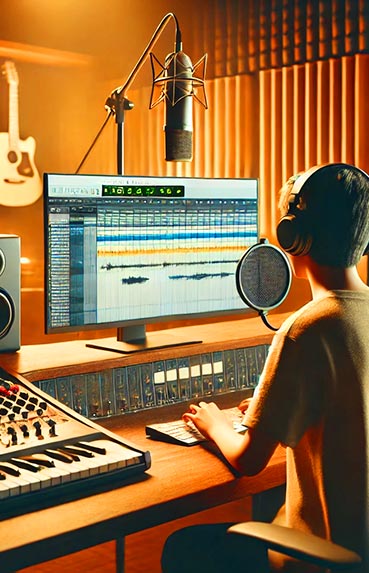Artificial Intelligence (AI) has emerged as a transformative force in various areas of our daily lives, and education is no exception. In a world where access to knowledge and personalized learning is becoming increasingly important, AI offers innovative tools and solutions to enhance the educational experience. As academic institutions and educators adopt these technologies, it is essential to understand how AI is shaping the future of learning and teaching.
Transformation of Personalized Learning
Personalized learning has long been a pursued goal in the educational field. AI is making this goal possible in ways that were previously unimaginable.
Adaptive Learning Platforms
Adaptive learning platforms use AI algorithms to analyze student performance and tailor educational content to their specific needs. These platforms identify each student's strengths and weaknesses, adjusting the difficulty level and type of content presented.
- Example: Khan Academy is one of the platforms that uses AI to personalize learning. Through tracking data, it adjusts lessons and exercises according to the student's progress.
Intelligent Tutoring
Intelligent tutoring systems provide additional support to students outside the classroom. These virtual tutors are available 24/7, allowing students to learn at their own pace and receive immediate assistance.
- Practical tip: Educators can integrate these tutors into their classrooms to provide extra help to students who need it, especially in complex subjects like math and science.
Improvement of Assessment and Feedback
AI is also revolutionizing the way assessment is conducted in education, providing faster and more accurate feedback.
Automated Assessment
Grading exams and assignments can be a tedious process prone to human error. AI offers automated solutions that not only speed up this process but also improve its accuracy.
- Example: Turnitin uses AI to detect plagiarism and assess the originality of written work, helping educators maintain academic integrity.
Personalized Feedback
AI systems can provide instant and detailed feedback to students, helping them understand their mistakes and improve their skills.
- Practical tip: Teachers can use AI tools to offer more detailed and specific comments, which can motivate students to improve and learn from their mistakes.
Access to Quality Educational Resources
AI is democratizing access to high-quality educational resources, breaking down geographical and economic barriers.
Digital Libraries and Open Resources
AI-powered search engines can help students quickly find the most relevant and high-quality educational resources online. This is especially useful in areas with limited access to physical libraries.
- Example: Google Scholar uses advanced algorithms to provide students with access to academic articles and scientific publications from around the world.
Translation and Accessibility
AI has significantly improved automatic translation and accessibility, allowing students to learn in their native language and facilitating access for people with disabilities.
- Practical tip: Educational institutions can implement AI-powered translation and accessibility tools to ensure that all students, regardless of language or abilities, can access educational content.
Fostering Creativity and Innovation
AI not only enhances traditional aspects of education but also fosters creativity and innovation among students.
Content Creation
AI tools can help students develop their creativity by providing them with new ways to create content, from art to music and writing.
- Example: Google AI's Magenta allows users to experiment with music creation using AI, inspiring students to explore new forms of artistic expression.
Innovation Projects
AI can be a powerful tool in innovation projects and project-based learning, allowing students to experiment with cutting-edge technologies.
- Practical tip: Educators can integrate AI projects into their curricula to inspire students to develop creative solutions to real-world problems.
Artificial intelligence is redefining what is possible in education, creating unprecedented opportunities for students and educators alike.
Challenges and Ethical Considerations
While AI offers numerous advantages, it also poses challenges and ethical considerations that must be addressed.
Privacy and Data Security
The use of AI in education involves the collection and analysis of large amounts of personal data, raising concerns about privacy and security.
- Practical tip: Institutions must implement robust and transparent privacy policies to protect student data and ensure compliance with regulations.
Algorithmic Bias
AI algorithms can perpetuate existing biases if not developed inclusively and fairly. It is crucial for developers and educators to be aware of these risks.
- Example: Some AI systems have shown gender or racial biases in their assessments. It is important to review and adjust algorithms to mitigate these issues.
Equity in Access
The implementation of AI technologies can exacerbate existing inequalities if equitable access is not ensured for all students.
- Practical tip: Policymakers and educators must work together to ensure that all students, regardless of socioeconomic background, have access to these technologies.
Future of AI in Education
The future of AI in education is promising, with ongoing advancements that will continue to transform the educational landscape.
Personalized and Lifelong Learning
AI will enable more personalized and lifelong learning, adapting to the changing needs of students throughout their lives.
- Example: Lifelong learning platforms like Coursera and edX are using AI to offer personalized programs that align with students' careers and aspirations.
Human-Machine Collaboration
The collaboration between humans and machines in the educational field will continue to evolve, with AI taking on supportive roles to complement human skills.
- Practical tip: Educators should view AI as a tool to enhance their teaching, rather than a replacement, and seek ways to integrate these technologies into their pedagogical practices.
Emerging Innovations
Emerging innovations in AI, such as augmented reality and virtual reality, will offer new opportunities for immersive learning experiences.
- Example: Augmented reality applications can transform how sciences are taught, allowing students to interact with three-dimensional models of molecules and biological systems.
In summary, artificial intelligence is reshaping education in profound and meaningful ways. By addressing challenges and seizing opportunities, educators and institutions can use these technologies to create a more equitable, accessible, and effective educational future for everyone.

















